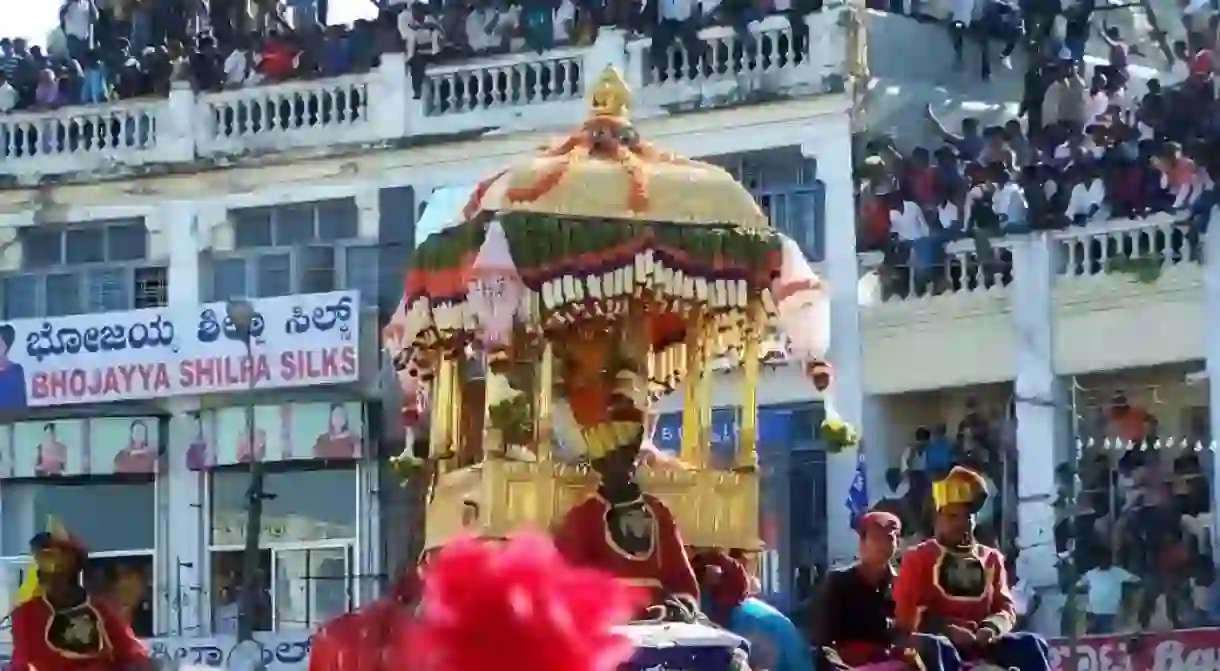A Three-Day Itinerary to Mysore, India

Boasting some of the most glorious palaces that recreate the past days of grandeur before the eyes of the stunned beholder, Mysore is aptly titled the ‘Heritage City of Karnataka’. Known for sandalwood, there is a pleasing fragrance permeating the city wherever you go. The broad, clean roads paved with wide footpaths offer perfect ways to explore the city on foot, and the quiet neighbourhoods lend a calm aura to this otherwise commercial city.
Day 1
The Mysore Palace complex is surrounded by several small and large restaurants which are ideal for breakfast. Mysore Masala Dosa and filter coffee will be a great option from any of these places.
Morning and Afternoon
Mysore Palace Complex
Building, Hindu Temple, Park

Begin your tour of Mysore by spending your first morning at the most iconic historical structure of Mysore, the Amba Vilas Palace, most famously known as the Mysore Palace. It was the royal residence of the Wadiyar dynasty and the seat of the Kingdom of Mysore from 1399 to 1950. The first palace in this land was built by Yaduraya in the 14th century. When you have worked up an appetite, leave for lunch to Infinit Lounge Bar which serves some great food with good city views from the rooftop. The palace complex also houses 12 major Hindu temples of which the oldest was built in the 14th century and the last in 1953. They boast elaborately ornate gopuras and intricate carvings.
Evening
Jaganmohan Palace & Art Gallery
Art Gallery, Building

Once you have enjoyed the views within the Mysore Palace complex, head to another palace built and used by the Wadiyar royal family, Jaganmohan Palace. It has been converted into an art gallery and also serves as a auditorium for dance shows today. The Sri Jayachamarajendra Art Gallery housed within the palace boasts more than 2,000 paintings belonging to various Indian styles of paintings. Wrap up the day with dinner in a cave-themed restaurant, Gufha, famous for their Murgh Patiala and Reshmi Kebab.
Day 2
Morning
Regional Museum of Natural History
Botanical Garden, Museum, Natural Feature, Park

Start day two with an early morning visit to Karanji Lake which is surrounded by a natural park consisting of a butterfly park and a walk-through aviary. The aviary is the biggest of its kind in India, with an artificial waterfall and two small water bodies. The Regional Museum of Natural History is located on the banks of the Karanji Lake with the beautiful sight of Chamundi Hills in the background. It exhibits include plants, animals and geology of the southern region of India. The Botanical Garden on the museum grounds has a collection of local trees and Ayurvedic medicinal plants.
Afternoon
Mysore Sand Sculpture Museum
Art Gallery, Museum

Next on the list is Mysore Sand Sculpture Museum, a very unique attraction in India. It is the brainchild of sculptor MN Gowri who is said to be the only woman sand sculptor in India. The museum is located on the road to Chamundi Hills and depicts nearly 16 different themes. The visitors are welcomed by a 15-feet-high sculpture of Lord Ganesha.
Evening
Sri Chamundeshwari Temple
Hindu Temple

Day 3
Morning
St Philomena's Cathedral
Cathedral, Church

Wellington Lodge
Building, Museum

A few decades back the dilapidated Wellington Lodge was repaired and converted into a museum and office of the Indira Gandhi Rashtriya Manav Sangrahalay with the aim of preserving traditional Indian art and culture. The next point of interest is this structure which is more than 200 years old and is one of the earliest colonial structures in Mysore. The courtyard is an open museum of terracotta sculptures and folk paintings and houses the National Museum of Mankind in the ground floor
Afternoon
University Folklore Museum
Museum, University

The University Folklore Museum is housed in the Jayalakshmi Vilas Mansion of University of Mysore. The museum has a collection of 6,500 artefacts which were collected from across Karnataka. A section of museum is dedicated to performance arts such as Yakshagana and Kathakali, housing ornaments, headgears, and masks used in these performances. P.R. Tippeswamy, a folklorist, was the first curator of the Museum. The museum also exhibits Palaeolithic tools discovered during the excavations in Koppa district.
Evening
R K Narayan House
Memorial

End the final day’s tour in Mysore by visiting R K Narayan House, which is a memorial dedicated to India’s beloved novelist R. K. Narayan. In 2016, Narayan’s residence was opened to the public by the government as a memorial museum dedicated to tell the story of his life and the life of his stories. He is the creator of the fictional town Malgudi and his characters resonated with Indian readers en masse. These stories were realist and narrated the daily trials and tribulations that made a villager’s life.













